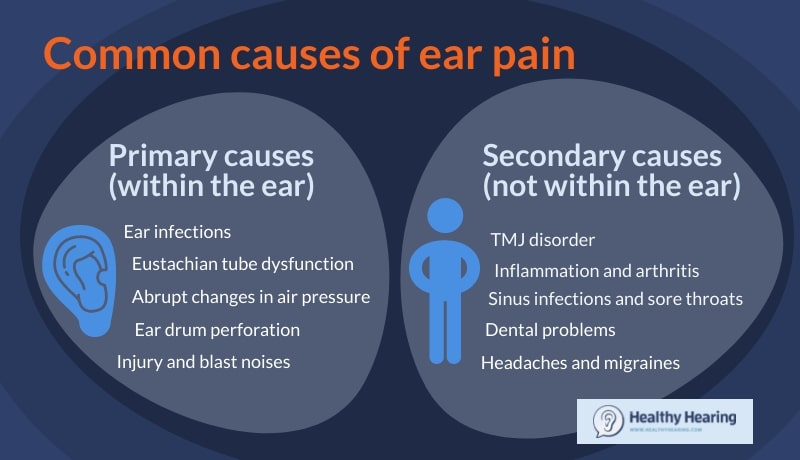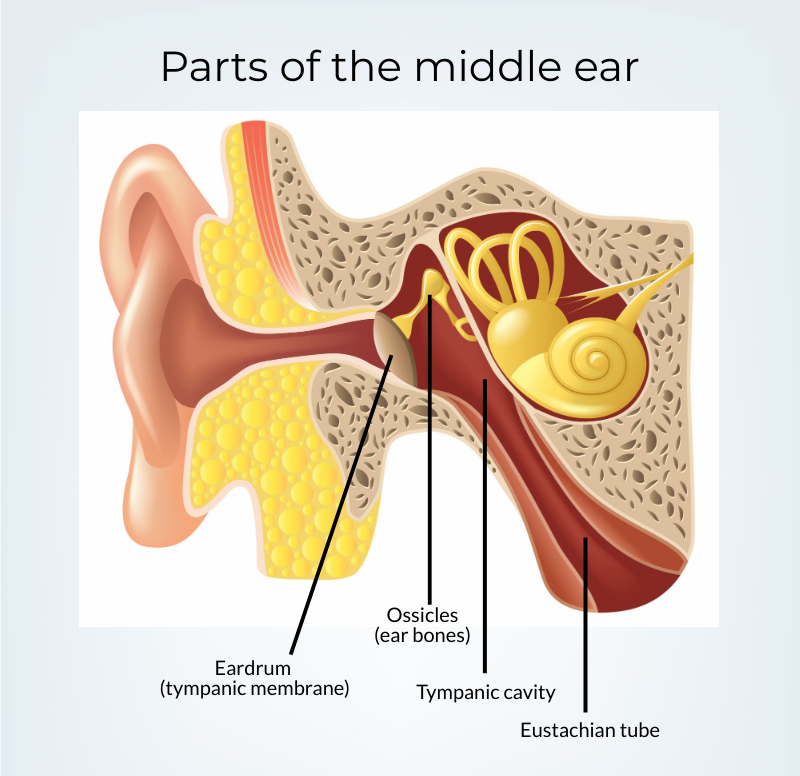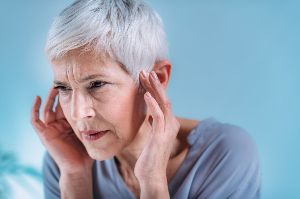Earache and ear pain (otalgia) - Causes and treatments - Healthy Hearing
There's nothing pleasant about experiencing pain in your ear, or in both ears. Medically known as "otalgia," ear pain can be fleeting or long-lasting, and because it can occur for a variety of reasons, treatment tactics vary.
Read on to discover some of the most common reasons people experience ear pain—along with details on why kids are so prone to ear infections, treatment options, and more.
What is ear pain?
That's a question with many potential answers. First, it helps to know that doctors think of ear pain in two categories:
- Primary pain caused by a problem in the ear itself
- Secondary pain that is felt in your ear but the problem is actually elsewhere in your body (referred pain)
When the problem is within your ear, the ear exam will be abnormal, often showing obvious anatomical changes, such as a swollen ear drum seen via tympanometry. That's not the case for referred ear pain, explains ear, nose and throat specialist Mark Nichols, MD, with Houston ENT & Allergy Clinic.
Here are some of the more common reasons for experiencing ear pain, in both categories:

Common causes of ear pain (within the ear)
1. Swimmer's ear
Ear pain from swimming, medically known as otitis externa, is an "infection of the tissues of the ear canal," Dr. Nichols says. One cue that it might be what you're experiencing: It'll feel tender when you press on the ear canal, he says. It can happen in any situation where water gets in the ear canal, not just swimming.
Symptoms of swimmer's ear include pain, swelling and purulent drainage, or pus draining out of the ear canal, notes Karen Hoffmann, MD, an ENT with Piedmont Ear, Nose, Throat & Related Allergy in Georgia. Swimmer's ear can also cause itchy ears.
Treatment options for otitis externa: Typically, your doctor will prescribe an ear drop with antibiotics for swimmer's ear, Dr. Nichols says. It's also important to keep your ear dry, he adds. If the infection is painful, you can take over-the-counter pain relievers like acetaminophen or ibuprofen.
2. Middle ear infection
A middle ear infection—aka otitis media—is the other main cause of non-referred ear pain, Dr. Nichols says. This can happen after a respiratory infection, cold, or sinus infection, he says.
A majority—75 percent—of children have an ear infection by age 3, and while adults can also get middle ear infections, it's not as common, according to the National Library of Medicine (NLM).
This type of infection can lead to pain, along with hearing loss and fluid draining from the ear—in children, other symptoms include fussiness, loss of appetite, fever, and difficulty sleeping.
Treatment options for otitis media: While treatment is important for ear infections, antibiotics are not pediatricians' first move, per the American Academy of Family Physicians. Instead, doctors may opt to treat a child's infection with over-the-counter pain relievers or ear drops for several days before writing a script for antibiotics.
3. Eustachian tube dysfunction

ear, leading to pain.
The Eustachian tube connects the middle ear to the back of the nose, equalizing the pressure in the ear, Dr. Hoffmann explains. If something goes wrong inside the tube—such as swelling from allergies—pain can result.
"If there's significant swelling, say when you get a cold or when you have a sinus infection, or if you just have bad allergies, it causes inflammation of that lining of that Eustachian tube," she says—the end result is an inability to equalize the pressure, which can be painful.
Treatment options for Eustachian tube dysfunction: There are several varieties of eustachian tube dysfunction, and treatment varies accordingly. Sometimes the same remedies that help with barotrauma (see below), such as yawning or chewing, can ease the symptoms. In other cases, medications or surgery may be required, according to the Cleveland Clinic.
4. Barotrauma
Do your ears feel extremely stuffy? You may have barotrauma, which occurs when the pressure within the eardrum and outside of it don't match, per Mount Sinai. Activities that lead to sudden pressure changes—like taking off in an airplane or descending during a scuba dive—are associated with it.
And, when you're all stuffed up from a cold or allergies, that can mess with the pressure as well.
How to reduce barotrauma: If pressure-related issues are occurring due to a cold or allergies, try decongestants. If you develop ear pain caused by air pressure when flying, you can try taking Sudafed (pseudoephedrine) or an over-the-counter decongestant nasal spray beforehand, Dr. Hoffmann says. Other easy tactics include chewing gum or yawning.
Most importantly: When flying, don't sleep as the plane lands. "You have the greatest increase in pressure as the plane is descending," Dr. Hoffmann notes. So that's when you'll want to be awake, yawning or chewing gum as the plane lands to keep the pressure on an even keel.
Note that a condition that affects the ear—Meniere's disease—also causes ear stuffiness, accompanied by hearing loss, ringing in the ears and dizziness. It is one of several conditions that cause a sensation of aural fullness, otherwise known as clogged ears.
5. Ruptured eardrum
Sharp ear pain can indicate a ruptured eardrum. In some cases, an ear infection or barotrauma can rupture the eardrum. Extremely loud noise and ear injuries also can perforate the eardrum, according to the UK's National Health Service. One of the most common causes? Inserting a Q-tip in your ear, or a similar object, in an attempt to remove earwax.
Along with ear pain, a perforated eardrum will cause hearing loss, tinnitus, dizziness and sometimes nausea. The good news? Damaged ear drums typically heal without incident. See a doctor if you suspect a ruptured eardrum.
6. Something stuck in the ear
Bugs, batteries, beads, hearing aid parts, cotton swabs are all commonly trapped items stuck in ears that can sometimes cause ear pain.
Causes of ear pain from non-ear problems (secondary otalgia)
Temporomandibular dysfunction (TMJ pain)
You can feel the temporomandibular joint if you press in front of your ear while opening and closing your mouth, Dr. Nichols says. It can get tender for people who have bruxism (aka teeth grinding).
This is an example of that "referred" secondary category of ear pain—the pain isn't due to a problem in the ear, but a problem elsewhere. "When you have inflammation of that jaw joint, all those muscles that move the jaw [are] also wrapped around the Eustachian tube, so you can get ear fullness and ear pain, but it's actually coming from something that's not in your ear," Dr. Hoffmann says.
Treatment options for TMJ: One tactic is placing people on a soft diet, so they don't have to chew as much, Dr. Nichols says. Other treatments include taking non-steroidal anti-inflammatory drugs (NSAIDS), such as Aleve, using a heating pad on the jaw, or massaging the jaw joint, he says. These tactics can improve things rapidly (in a week or two), Dr. Nichols says. But if they're not effective, the next step is typically getting fitted with a night guard at your dentist's office.
Inflammation and arthritis
If people have arthritis in their neck—or a nerve there gets pinched—it can lead to ear pain, Dr. Nichols says. Another possible reason for referred ear pain: a tonsillectomy. This is due to inflammation following the surgery, along with referred pain from the nerves that stretch from the back of the throat to the ears, Dr. Hoffmann says.
"So some of the pain that we see in the ear or people feel in the ear is actually due to inflammation of nerves elsewhere," Dr. Hoffmann says.
Other common causes of ear pain

can still sometimes cause earaches.
Some other common causes of ear pain, according to the Cleveland Clinic, include:
- Something stuck in your ear
- Viral infections like shingles that lead to sudden hearing loss
- Inner ear infection (aka otitis interna)
- Sore throats and sinus infections
- Dental problems
- GERD or acid reflux
- Headaches and migraines
Why are earaches so common in kids?
"Part of the reason kids have more issues with their ears in recurring ear infections and also some Eustachian tube dysfunction is because their Eustachian tube isn't fully developed yet," Dr. Hoffmann says.
For kids, the way the tube is angled makes it more likely they'll develop an ear infection and have fluid in their middle ear space after an upper respiratory infection, she says.
The good news: As kids get older, they grow out of this tendency, as the angle of their Eustachian tubes shifts.
There's another key reason why children are more likely to get ear infections: Their immune system is still developing and isn't as well-equipped to ward off infection.
What to do it if your hearing aids hurt
If you're experiencing pain or irritation from your hearing aids, see your hearing care provider for help.
When hearing aids fit correctly, they feel comfortable and should never hurt your ears or cause earaches. If you're experiencing pain or irritation from your hearing aids, see your hearing care provider for help.
When should you see a doctor for ear pain?
That depends.
"Ear pain is very common," Dr. Hoffmann points out. And some occurrences—such as barotrauma while on an airplane—are relatively fleeting.
Some signs you should visit the doctor include vertigo, fever, hearing loss, discharge, or persistent pain. In most cases, a primary care doctor can help, but in more complicated cases, you may be referred to an otolaryngologist for your ear pain.
"If it's something that occurs very infrequently, and is not severe and doesn't last very long, it's probably nothing to worry about," she says.
Comments
Post a Comment